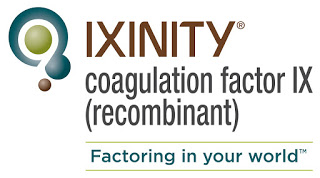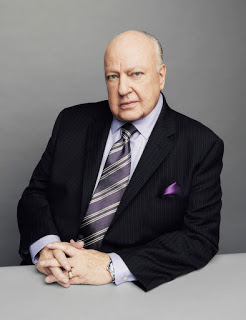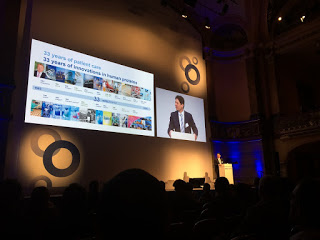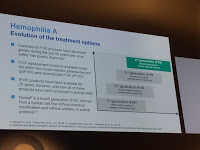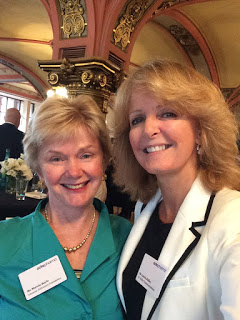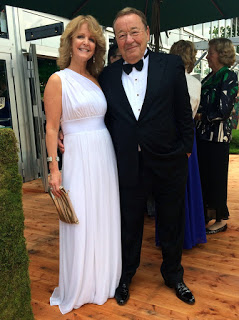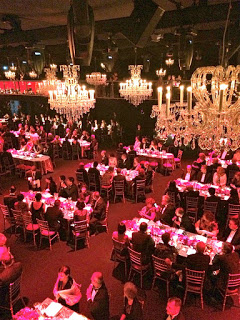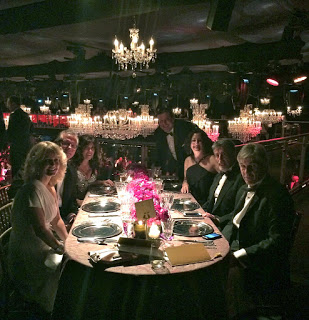Ape Over Hemophilia
in April, I spent two days visiting the amazing Bwindi Impenetrable Forest,
which hosts the largest number of mountain gorillas in the world. These are
different than the ones you see at the zoo, which are Lowland gorillas.
Mountain gorillas are protected by law, and Uganda has done a spectacular job
at warding off poachers and protecting these highly intelligent,
family-oriented animals. With limited numbers of passes each year, I was lucky
to get one and view two different families. Below is my experience with one of
them.
us that gorillas share 98.8% of our DNA, I was shocked. I wondered, can
gorillas get hemophilia? I imagine they could. There are less than 1,000 of
them, living in four national parks in three countries. If 1 in 5,000-10,000
human males are born with hemophilia, perhaps there are no gorillas with
hemophilia… yet?
everything in moisture, which heightens the colors of the emerald forest and
yellow flowers. I hear birds repeating their songs, the constant background of
cicadas, the gentle rains. Every now and then one of the workers at the Gorilla
Forest Sanctuary—Nicholas, Eli, Judith— stops to see how I am, and how the day
was. It has been a marvelous day.
in my safari tent to the distinct three-note sound of a local bird, and the
whirring crickets. It’s peaceful here. The day was overcast and cool. After
breakfast, I skipped down the red stones of the Sanctuary, took a left on the
gravel road and within a few hundred feet reached the sloping driveway of the
Ugandan Wildlife Authority. I was the only one from our lodge; a few people
from other outfitters joined us, milling about on the lawn. We were to track
the “Rushegura family” of apes. This is an active group, on the move, comprised
of 19 family members. (Read more about this family here)
Stephanos and Leeza from South Africa; Ali, blonde, from the UK, who had asthma
and was probably my age or a bit younger; a young woman from Israel; Gladys
from the UK, who had a swishy ponytail and riding boots that looked wrong for
this kind of hike; a tall guy, my age, with glasses and was very happy; and a
German lady, tall and blonde.
dark-skinned man with a chiseled face and thin mustache, small but wiry,
donning his army green wildlife outfit. As we set out on a long, flat dirt road
for 30 minutes, we had a chat. I asked him how long he had been a guide. He
replied 19 years, which seems a long time. “You must have been here pretty much
when the forest was opened, right?” I surmised. “Yes, back in 1997. I know a
lot of stories about the gorillas.” I asked if he then knew of Thor Hanson,
author of The Impenetrable Forest,
which I had just read.
exclaimed Gad. “You know when he writes about that family whose bananas were
being eaten by the gorillas?” Yes! I told him, Chapter 16. The gorillas kept
raiding the village farmers’ field, particularly banana trees, as they love the
pulp (and not the bananas, contrary to pop culture). It was delightful to share
my enthusiasm about the book (which is well written) with someone. He shared
some stories about him being attacked by a gorilla, and still carrying the
puncture wounds. We fell in to chatting quite a bit, and I told him he should
write a memoir about his years: how the forest has grown as a tourist business;
who were some of his memorable guests?
dense forest after an hour. The gravely dirt road became a trail, and the real
hike began. I have never experienced any hiking like this. For the next two
hours, we hacked, stumbled, slipped, hauled, crawled and grabbed our way up the
mountainside.
movin’,” one of the guides said, translating from the walkie-talkie
conversation he just had with the trackers. The four trackers—armed with
machetes for the undergrowth, and rifles for the wildlife— were far ahead of
us, scouting for the Rushegura family. This meant we would have to follow them
up the mountainside. It’s not called the Impenetrable Forest for nothing. The
trail very quickly turned into a 45° hike, through thick vegetation designed by
Nature to keep trespassers out. The light chitchat that bounced back and forth
between the trekkers petered out, as each person focused on where each foot
would land. It was an exercise in pedestrian strategy: if you put your foot on
a root as a launch pad, you might slip from its slimy covering, or it might
twist suddenly free and ensnare you. If you fall, you crash on more roots,
downed branches, wild vines. You put your foot up on the hill sideways (you
can’t often go straight on because the angle is too steep), ducking to avoid
creepers, vines, branches above you and at face-level; you reach up, dig your
walking stick with the carved gorilla head on it into the muddy ground above
you, pull and push, then steady yourself by grabbing a tree to hoist yourself.
Ouch! The trees are covered with moss and usually thorns from some of the
creepers. You quickly learn which trees and creepers to avoid. All the while
you ascend, more and more, higher and higher. Sweat pours off you, the trees
above drip on you, the mud splatters you. “Trampled Underground” played in my
head.
qualifying for that title, is strewn with rotted vegetation: brown leaves,
moldy green ones, moss, and a cat’s cradle of vines that twist and ensnare. At
times you lose your balance, and start to waver downwards. When you
overcompensate and pitch forward your foot most likely is entrapped in the
vines and roots, holding you back, so you start to fall faster into the muddy
hillside. I lost my balance many times and once fell forward on the narrow and
treacherous hillside trail, but couldn’t right myself because anywhere I put my
hands I hit thorns. “Give me a hand up,” I pleaded to the South African couple
near me and they righted me. We then had to stamp on the vindictive vines until
my foot was free.
small step for mankind. We still had two more hours of this just on the way up.
on the botanical traps at our feet, we were surrounded by a primeval forest,
which only knew how to attack and defend. Creepers encircled trees, trying to
reach the top of the canopy to get sun, and strangling some trees over time.
Certain trees grew immensely big, while saplings sprung up like mushrooms
underneath. Every type of green thing known to humankind seemed to grow here,
with no inch spared for space, except for what we hacked.
away with their two-foot long machetes, called pangas; branches lopped off trees in seconds. It seemed horrifying
to watch them mutilate trees this way; in the States we try not to harm our
trees. But you soon want a machete yourself to protect your arms and hands from
the insidious thorny trees and stinging nettles.
plump, blind and primitive, lying on the sodden trail. I pointed it out and our
guide told us it was a neera. To
amuse and shock them I picked it up; it worked. Suddenly my hands felt stinging
and I hastily put it back. I couldn’t imagine why it stung me until I saw the
safari ants crawling all over it. Later I saw a white shell, a smaller version
of the ones we find at the beach, curled over and over to form a funnel. It was
empty, and once belonged to a snail, probably a long forgotten victim of the
safari ants as well.
briefly, to catch our breaths as we are all heaving now, to sip water, and to
listen to the walkie-talkie chatter of the trackers ahead. Gorillas still on
the move. We wipe off sweat and start again. There is no small talk from anyone
now; we are in our own little endurance trek. Ali leaned against a tree,
seemingly defeated. We still have an hour to go. “Altitude sickness,” she says, but I’m not sure that’s it. We are up a high
mountain for sure, but not the 13,000 feet where this sickness would manifest.
It’s just a very strenuous hike and someone should be relatively fit to tackle
it.
kindly hold hands with the women in the group. My porter, Stifa, is a girl
younger than my youngest and I hired her as a community investment. Local
porters depend on tourist dollars to help their community.
with the trackers on flat ground, and they look as exhausted as we do. Now we
are all gathered in a small clearing; there are big potholes of mud around us.
“Elephant,” one of the trackers said. Yes, elephants live up this wild
mountain! Now the trackers hack the vines and branches trying to keep us from
the gorillas, with a vengeance. They feel the gorillas are close by. Another 30
minutes of hacking, stepping, climbing.
of the gorillas. Sure enough, around a tree caged with vines and smaller trees,
is a lone gorilla, stripping leaves off a branch with his teeth. We circled
about and watched as he munched. He was not concerned with us; behind us, the
Rushegura group. The silverback, “Mwirima,” lay on his back, one foot high in
the air. Two babies, just a few months old, their wobbly heads trying to focus
on us, lay in their mothers’ arms. One had a wildly wooly mane of hair. The
struggle to get here took the wind out of us, and the gorillas were somnolent
and lazy. But we stood about, snapping photos, quiet and respectful. None came
near us. They are habituated to humans, meaning that over time, the park
rangers have approached the group every day for an hour, for years, to get them
accustomed to humans. They are wild, no doubt, and dangerous. One gorilla could
easily kill you. The silverback weighs about 400 pounds. But they have been
trained to be in the presence of humans and tolerate them. To visit them you
must be quiet, move slowly, don’t go near them (though they might come near
you), do not set off any flash photography (it frightens them, reminding them
of lightning). And you can’t trek to see them even if you have a bad cold.
Because gorillas share 98.8% of our DNA, they are susceptible to catching our
germs. This made me wonder about hemophilia; can they develop it? No one seems
to know.
feasted on the forest and were sleepy. Only the infants tried to break away and
were very curious about us. Each time they tried to climb down off their sleepy
mothers, the mothers gently took their arm and placed them back in their hold.
The mothers were incredibly tender towards the infants.
revealed Ali made it after all! I quietly congratulated her and she immediately
credited Gad for getting her there. “I have been a guide for 19 years,”
reminded Gad. “I know people want to come see the gorillas. So I know how to
make them come up the hill.”
burst overhead, warning us that a downpour was imminent. Gad politely suggested
it was time to move. We all donned rain gear, which would prove useless within
minutes. We bade the gorillas silently good-bye and began a slow march down the
mountain. It took us only 90 minutes, half the time, but was every bit as
treacherous. The rain burst like water sliced open from a huge camelback
bladder in the sky. It hammered us relentlessly. My hood—I had forgotten to
flip it up after I put on my trekking hat. When I did, of course it was filled
with cool rainwater, which slid down my back uncomfortably. Within 15 minutes
we were soaked to the skin, and soon no one cared anymore that we were wet. We
had to focus on our feet again. Gravity pulled us, but the roots and vines
weren’t done yet. Somehow I sped ahead of the group, keeping up at all times
with the trackers. Through the rain, I watched as the lead tracker followed a series
of yellow slashes on the trees, and neatly halved saplings; these were his
markings for finding our way out. Otherwise, how would he know? They don’t use
GPS or even compasses.
onto a sapling as he walked, pulling it toward him then releasing it suddenly.
It snapped back and whipped my left thumb painfully. Another time, I slipped in
the mud—no surprise as now a stream of mud, clogged with decomposing leaves,
became our trail, and the sudden thought that these beheaded saplings could
easily impale someone. I vowed not to fall again.
enjoy the beauty of the rainforest. Everywhere you look, there was green: jade,
emerald, forest… all shades and types. Ants crawled on the ground, birds
occasionally chirped, but mostly the forest was deathly quiet, except for the
rush of rain. The stinging nettles still caught on my pants relentlessly, and you released them like a cat’s claws, pulling them back first
and then letting go. All of our clothing had minute holes in them from the nettles,
and the next day, I would awake with dozens of small bumps on my legs, itching
furiously where the nettles stung.
well ahead of the group. We eventually came to the waterfall, about 40 minutes
from the Uganda Wildlife Authority building. The rain tapered off and we took
photos in front of the falls. The falls pounded the rocks like white foamed
fists. Nicholas had dashed ahead of us, and had stripped off his shirt to clean
the mud off him in the pool. He looked so happy, and there was a certain
simplicity about everything. Wet, muddy, sweaty, we were happy. Gad wanted to
know what we wanted to do: eat lunch in our raincoats, in the rain, next to the
waterfall, or continue? I wanted to continue on, not interested in eating.
Everyone stood about, not able to make a decision. I simply said, all in favor
of eating lunch here? The South African couple raised their hands hopefully.
All in favor of moving on? Everyone else raised their hands. “Sorry!” I offered
not apologetically. On we trekked!
excursion was easier, even in the now light rain. The trail evened out but
remained muddy, rocky, slippery, serpentine. It eventually spit us out on the
main road again, that led to the UWA. Gad exclaimed, “You’re fast! Do you want
to be a tracker?” Of course, I replied!
the main building, I thanked Stifa, gave her most of my lunch, a big tip and
pay, and then walked back to the Sanctuary, soaked, muddy and sweaty… and
thrilled.
gorillas here.




